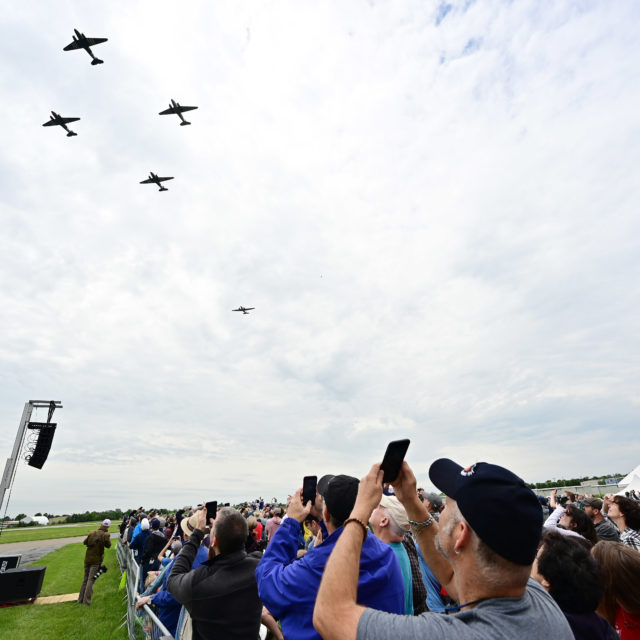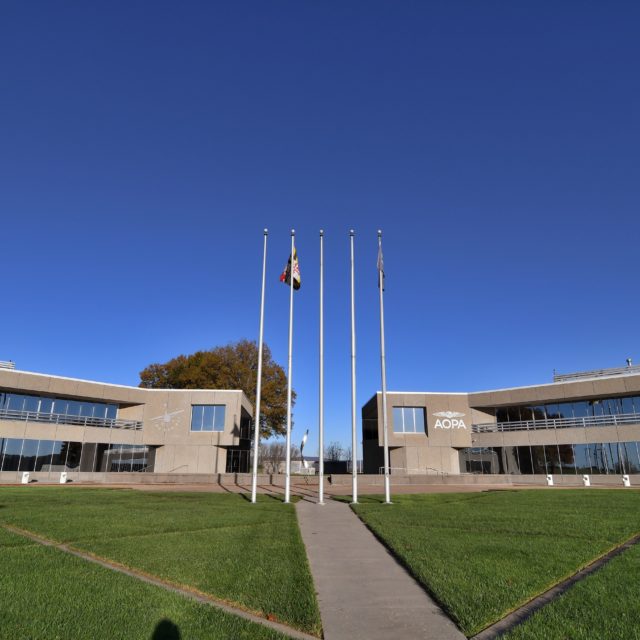Written by: Forrest Popkin, AIA, Secretary East Frederick Rising
Many may not give it much thought; few may not even know it exists; East Frederick Rising turns its attention to both the City Airport and the Aircraft Owners and Pilots Association, an organization headquartered in Frederick supporting pilots across the United States.
The Frederick Municipal Airport, or FDK, has a long history and April 2020 will mark its 71st anniversary. But who uses it? What is the purpose? How does AOPA support the pilots that fly there? We look to explore our very own airport and how it serves the City as a whole.
The Federal Aviation Administration designates Frederick’s own airport as a “full-service general aviation reliever airport.” There are many classifications, but know that the ‘reliever’ part means that the runway serves as a reliever of volume of general aviation traffic from Thurgood Marshall Baltimore Washington International Airport (BWI) and the full service implies all the support for recreation, training, maintenance and business flights.
Frederick’s mayor and city reprioritized the airport as an economic asset in 2013. The stance is that the airport is one of Frederick’s top transportation and business assets that provide an engine for the local economy and helps to increase the tax base. The city wants FDK to be seen as both safe and affordable for recreational and business air travelers. But we have competition in local airports, and although many may assume that is Hagerstown is the primary competitor for DC market share, it is actually Manassas Regional Airport that muscles for business along the I-95 and I-270 corridors for DC traffic. Frederick banks on the appeal of our highway access, runway length and local amenities for corporate planes. But why would anyone wish to fly into the Frederick airport? How does Frederick hope to be considered the Executive Airport in the National Capital Region? And where does AOPA fit into this puzzle?

SOME QUICK FIGURES ABOUT THE AIRPORT
The city confirms that FDK has 9 businesses directly located at the airport, which includes: two maintenance shops, avionics, and three flight schools, including a helicopter school. About 150 people are directly employed at the airport and many more indirectly supported by the activities at FDK. In addition, The Aircraft Owners and Pilots Association, or AOPA, is located directly off the airport property. The organization employs scores of pilots, flight instructors, and support staff who take full advantage of the airport for their personal flying as well as to provide great service to members. AOPA’s mission includes “advocating on behalf of our members, educating pilots, non-pilots, and policy makers alike, supporting activities that ensure the long-term health of General Aviation, fighting to keep General Aviation accessible to all, and securing sufficient resources to ensure our success.”
And there are countless other indirect beneficiaries. The airport currently houses about 200 aircraft. Assistant Airport Manager Andrew Moore, C.M. mentioned Boeing anticipates 700,000 more commercial pilots will be needed nationally over the next 20 years. Our airport is directly helping fulfill that in our region. He added “here at FDK about 350 new pilots or advanced ratings are issued ever year, or about one a day.” Revenue is generated from the airport’s ground rents, hangar rents, and the fuel sales. The airport also gets much in federal and state grants. The split is 90% federal, 5% state, 2.5% county, 2.5% city. In about three years when the airport land debt is retired, the goal is for FDK to be less reliant on taxes from the city general fund and be sustained its own income stream. That is where some of the upcoming improvements come in.
THE RUNWAY
There are a few improvements to the airport set to occur starting 2020. One is lengthening of the runway by 600 feet and another is the construction of hangars, which will be a partnership with AOPA.
How much difference does 600 feet of runway make? A lot when you are being compared by business aviation dispatchers on where to send aircraft for executive travel. Location, traffic, amenities and length of the runways are all considerations. Until the runway extension is added to FDK’s 5,000-foot runway, these dispatchers may rank another city safer or having better capacity and will skip out on Frederick. By Fall of 2020, the runway extension project is set to be complete increasing FDK’s main “runway 5/23” to 5,820 in length.
Large companies are looking at airports, locations, amenities and ease of use to gain a competitive edge in their market where speed is everything. So, the 600 feet may not seem to be a big deal, but it gets noticed by corporate dispatchers plugging in data to find the more efficient place to land. General aviation airports also appeal to a small business owner who looks at a geographic area that would otherwise be limited by highway arteries/traffic and can make a business decision to work and live in Frederick due to availability of resources.
Other users FDK airport include: the State Police’s Medevac Trooper 3 helicopter, Search and Rescue, organ transplant operations, volunteer medical transit, alternative landing site for Camp David, arrival and departures for collegiate sports teams and even blimps overnight prior to going to DC and Baltimore. Anne Arundel Community College and CCBC use the airport for their flight training programs, programs for the Maryland State Police and supports helicopter training courses.

HOME TO AVIATION CULTURE
AOPA is about representing these types of users of the airport. Founded in 1939, moved to Frederick in 1983 with support from the City of Frederick, AOPA moved to Frederick to be located on an airport near Washington, DC, where their 300,000 members and growing could fly in for a visit whenever they want. According to Senior Vice President Tom Haines of AOPA, “say ‘Frederick, Maryland,’ to anyone in the aviation community most anywhere in the world and they will know of it because of AOPA’s presence here.” And he is not kidding:
- Frederick is noteworthy for Aviation training and advocacy in the US, much in part to the work by AOPA.
- Frederick is home to the world’s largest aviation magazine, “AOPA Pilot” and is by far the largest circulating aviation magazine in the world.
- Frederick is home to the AOPA You Can Fly programs, including the High School Aviation STEM curriculum used every day by more than 5,000 students in 161 schools in 34 states. The curriculum is free to any high school that wants it. The program is funded by generous donations to the AOPA Foundation, the charitable arm of the organization.
- The AOPA Foundation awards more than $1 million in scholarships to help youth begin flight training. In addition AOPA gives away hundreds of thousands of dollars in scholarships to pilots seeking to upgrade their flying skills.
- Frederick is also known throughout the country as a focal point of aviation safety data and research through programs such as the AOPA Air Safety Institute or ASI. The ASI creates its own training content, providing it free to all pilots. The award winning content was accessed 7.7 million times in 2019 in both digital formats online and through our series of in-person safety seminars around the country.
Part of Haines job is to get the word out about AOPA. He began in 1988 as one of the Publications staff. The once associate editor moved up until he was named editor in chief and Senior Vice President of Publications in 1994. The media landscape has shifted over the decades, but AOPA keeps up. They produce email newsletters, web content, video, social media, podcasts, events, and much more. AOPA even has a television studio to record webcasts.

Photo provided by AOPA
PARTNERSHIPS FOR ECONOMIC DEVELOPMENT
The hangar development project anticipate in the first 24-month phase, AOPA will deliver six 60 feet by 60 feet hangars and thirty 45 feet door T-hangars. But that is just one of many partnerships. AOPA works closely with the city on many projects—both from an economic development standpoint, highlighting the vibrancy of the airport and the tremendous access it provides to the city from any place in the country—and in making the case for why it deserves FAA funds for upgrades and modernization. AOPA is also a tenant of the city. They leased an old hangar at the south end of the airport from the city and invested hundreds of thousands of dollars into modernizing it as both a place to keep its airplanes but to also make it into the AOPA National Aviation Community Center, or NACC. The NACC has hosted many community programs in recent years, many of which attract national media coverage to Frederick. Their events have highlighted aviation history, aviation government meetings, international delegations, many local school groups, scout meetings, and community service organizations. Two recent such events were the hosting of the D-Day Squadron at the AOPA Fly-In in May 2019 and the December 2019 100th birthday party for famed Tuskegee Airman Brig. Gen. Charles McGee. These gained Frederick national attention.
AOPA’s Haines put it rather concisely, stating “an airport can serve as an economic engine for many types of businesses. Access to airports or lack of access can lead to enterprises making their decision to move to Frederick or not.” Haines personally noted his vision for East Frederick is one that continues to develop, while protecting the important safety zones around the airport runways, creating vast amounts of open space suitable for parks and recreation, and allowing the airport to thrive and attract new businesses. He painted a picture that someone flying in may see Frederick: the city is stunning from the air and its proximity to farms, the Catoctin Mountains, and the Monocacy River make it a very desirable place to live.
WHAT IF I WANT TO LEARN MORE?
Airport Management recommends all visit the observation area as the weather warms to watch planes take off and land. It was even hinted that as the airport grows its influence, perhaps an observation/visitor building can be added to the campus. Pay attention for events, like the annual 5k race on the runway. For additional information about both FDK and AOPA, please check out: FLYFDK.com and aopa.org/